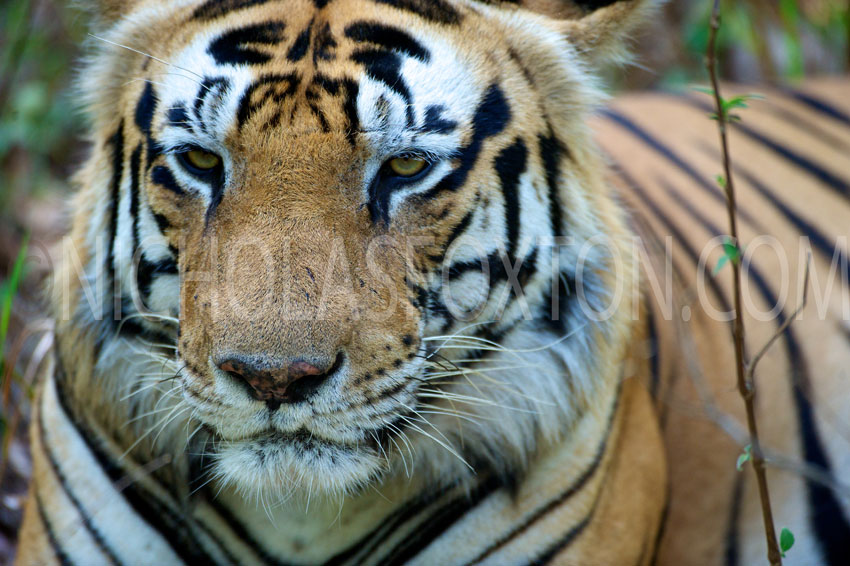This is a dominant male in one of the tourist zones in Kanha, nicknamed Muna by the guides after one of their colleagues.
Muna is probably the most photographed tiger in Kanha, particularly given the odd pattern of stripes on his forehead which are instantly recognisable. Detail here ;
Despite the obvious size and power of an adult male tiger (large enough to tackle Gaur Bulls and Sambar Stags, dominant males do appear to spend rather a lot of time patrolling their large territories (around 60% larger than female territories). Tigers are polygamous so each male can and will mate with several tigress whose territories overlap with his. In purely biological terms this makes the most use of his relatively short period of being fertile and of having access to receptive females. Hence tigers who control a larger home territory have more opportunities for mating and of passing their genes on. Females, once impregnated by the resident male are occupied with cubs for the next two years.
Males accordingly defend their territory in a variety of ways. Firstly there is extensive scent marking which acts as a warning and method of communication between tigers. I’ve seen but never photographed the curious grimace known as Flehmen where a tiger sticks out its tongue and draws back its lips to bare its teeth, which wafts the scent to an organ in the mouth (Jacobson’s Organ) that interprets the pheromones. These scent markers identify whether it was left by a female in oestrus, or a male rival or threat and the tiger will then respond accordingly. So a smaller male will probably avoid contact with the dominant male unless he is feeling particularly lucky or brave, or emboldened by a whiff of a fertile female. You may be imagining here a feline version of the British advertising campaign for Lynx bodyspray; documentary realism if you are a teenage boy and wry comedy for everyone else and you’d be about right.
Secondly, of course there is always the option of brute force and tiger fights are by all accounts extraordinary events and high on my list of things that I want to photograph. Typically in these fights between dominant males and interlopers the powerful forearms and paws are used. There are some terrific photographs in Valmik Thapar’s excellent book Tigers -My Life, which I managed to carry on as hand luggage on the flight back from India last week.
One of the younger males in Kanha that I photographed has what appear to be claw marks from a fight on the inside of his left forearm. I chatted to several guides and its hard to imagine what else these wounds could be. This is the male on his way to rest in a pool. The wounds are a reminder of the power of the beast.
I’ll leave the last word to Fayrer’s The Royal Tiger of Bengal, who points out that ‘Those who have seen the tiger when stripped of his skin, can hardly fail to have been struck with the grotesque resemblance to a gigantic human form which is presented by his sinewy and muscular frame as the arms are stretched out on either side. The vast shoulder, arm, forearm, wrist, and hand have a wonderfully anthropoid appearance’.
To which my immediate response is what is so wonderful about the apes, but that will have to be for another time !



